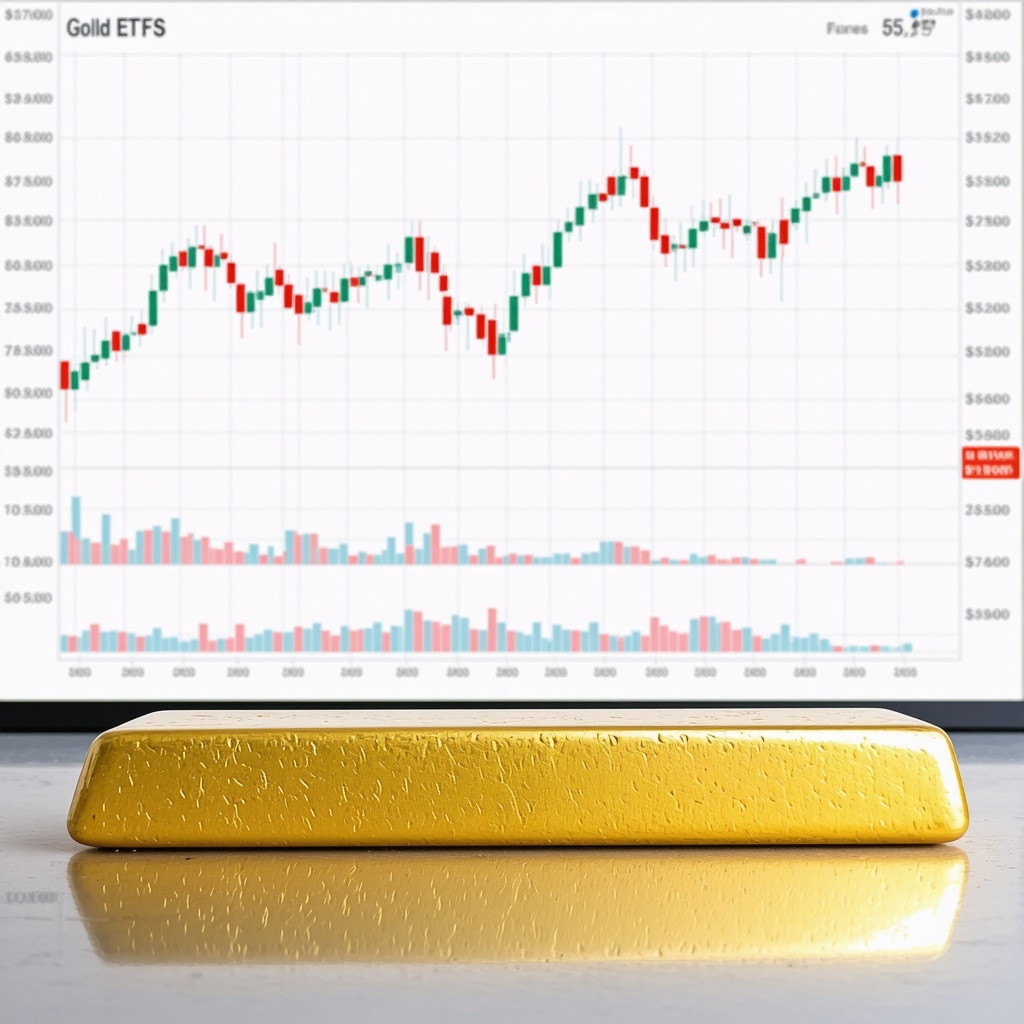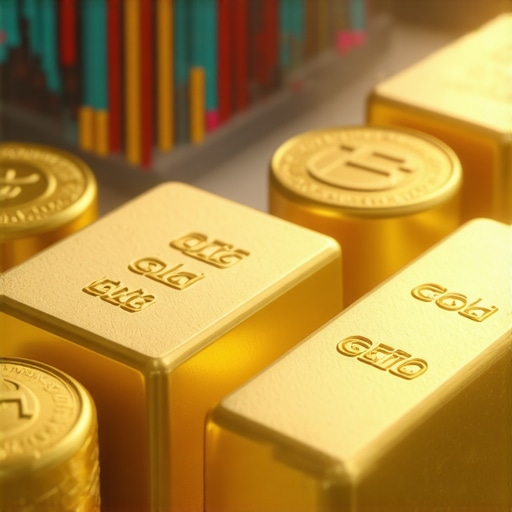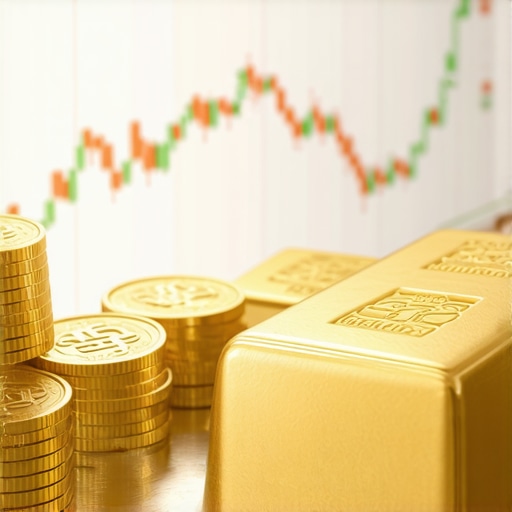Unlocking the Glitter: Exploring Gold ETFs and Gold Futures
Gold has long been revered as a safe haven asset, especially during times of economic uncertainty and inflationary pressures. Yet, when it comes to investing in gold, the pathways diverge significantly. Two of the most prominent avenues are Gold Exchange-Traded Funds (ETFs) and Gold Futures contracts. Each offers unique opportunities and risks, making the decision nuanced rather than straightforward. Understanding these differences is crucial for investors aiming to maximize returns while managing exposure effectively.
Gold ETFs: Seamless Access to Physical Gold’s Performance
Gold ETFs represent shares in a fund that holds physical gold or gold-related assets. They provide investors with the advantage of liquidity, ease of trading on stock exchanges, and relatively low entry costs. For instance, an investor buying shares of a leading gold ETF essentially owns a stake backed by physical gold stored securely by custodians. This structure offers a transparent and cost-efficient way to track gold prices without the hassles of storage or insurance.
Moreover, Gold ETFs tend to be less volatile compared to futures, as their value closely mirrors the spot price of gold. They suit investors seeking long-term appreciation and portfolio diversification. However, the returns are generally limited to the price appreciation of gold itself, minus management fees.
Gold Futures: Leverage and Speculation Unveiled
By contrast, Gold Futures contracts are agreements to buy or sell a specified quantity of gold at a predetermined price on a future date. These instruments are predominantly used by traders and speculators aiming to profit from short-term price movements. The hallmark of futures is leverage, allowing investors to control large amounts of gold with a relatively small margin. While this amplifies potential gains, it equally magnifies risks, including the possibility of significant losses exceeding the initial investment.
Futures trading demands a sophisticated understanding of market dynamics, margin requirements, and timing strategies. Unlike ETFs, futures contracts have expiration dates, necessitating active management to avoid physical delivery or to roll over positions. This complexity often deters casual investors but attracts those seeking higher returns through tactical trading.
Which Investment Yields Better Returns in Practice?
The question of which yields better returns is multifaceted. Historical data shows that over extended periods, Gold ETFs generally offer steady gains aligned with gold’s price trends, making them suitable for conservative investors. Conversely, Gold Futures can deliver superior returns in volatile markets due to leverage but come with heightened risks and require active engagement.
For example, during sudden geopolitical tensions or inflation spikes, futures traders can capitalize on swift price swings, while ETF holders experience gradual value changes. However, misjudged futures positions can lead to rapid losses, underscoring the importance of risk management.
It’s also essential to consider costs: ETFs incur management fees and bid-ask spreads, whereas futures involve brokerage commissions and margin interest. Tax treatments vary as well, with futures often taxed differently than ETFs, influencing net returns.
Strategic Synergy: Can Investors Combine Both for Optimal Outcomes?
Experienced investors sometimes blend Gold ETFs and Futures to harness the benefits of both. ETFs provide portfolio stability and ease of access, while selective futures contracts enable tactical exposure to price volatility. Such a hybrid approach demands expertise but can enhance return profiles while balancing risk.
For those intrigued by integrating these strategies, our detailed guides on Gold Futures Explained: Risks and Rewards for Traders and Ultimate Guide to Gold ETFs for Beginners offer invaluable insights.
Expert Perspectives Backed by Market Realities
Academic research and market analyses from reputable institutions like the World Gold Council emphasize that gold investment vehicles cater to differing investor profiles. According to the 2023 World Gold Council report, ETFs dominate as a preferred choice for long-term holders seeking simplicity and liquidity, whereas futures attract speculative and hedging activities by institutional players (World Gold Council Research).
Ultimately, the decision hinges on your investment horizon, risk tolerance, and market savvy.
Curious about how these options fit into your personal portfolio strategy? Share your thoughts or questions below to engage with our community of gold investment enthusiasts.
Balancing Act: Personal Reflections on Managing Gold ETFs and Futures
From my own experience navigating gold investments, the dance between Gold ETFs and Futures is fascinating yet intricate. Early on, I leaned heavily on Gold ETFs, appreciating the simplicity and the comfort of knowing my exposure was directly tied to physical gold prices without the complexities of contract expirations. This approach felt like a steady companion during volatile market phases, providing a reliable hedge against inflation and economic uncertainty.
However, as I grew more confident, I explored Gold Futures for their leverage potential. I remember one particular episode when global tensions heightened, and gold prices surged in rapid succession. Utilizing futures contracts, I was able to capitalize on these short-term swings in a way ETFs simply couldn’t match. But that thrill came with lessons — the margin calls and the need for vigilant monitoring taught me the importance of disciplined risk management.
Practical Tips for Navigating the Complexities
For anyone considering this dual approach, here are some practical nuggets I’ve gathered:
- Understand Your Risk Tolerance: Futures can amplify losses as much as gains. If you’re risk-averse, maintaining a heavier ETF allocation might be wise.
- Stay Educated: Futures demand a clear grasp of market timing and margin requirements. Resources like the Gold Trading Basics guide helped me build foundational knowledge.
- Regularly Review Portfolio Mix: Market conditions evolve; so should your strategy. Periodic rebalancing ensures your gold investments align with your financial goals.
- Leverage Technology: Tools for tracking gold price trends and margin calls can prevent unpleasant surprises.
How Can One Decide the Right Gold Investment Blend?
This question often bubbles up when discussing gold investment strategies. It’s not a one-size-fits-all answer—personal financial goals, investment horizon, and comfort with complexity all play roles. For instance, if you prefer a hands-off approach, Gold ETFs offer a hassle-free avenue. But if you thrive on market analysis and quick decision-making, dipping into futures for tactical plays might suit you better.
I recall reading insights from the World Gold Council, which highlights that many investors find value in combining both to optimize risk-adjusted returns. Their research emphasizes that diversifying gold investment vehicles can help cushion against market swings while capitalizing on opportunities.
Learning From the Gold Market’s Pulse
Keeping a finger on the market’s pulse is vital. I’ve found that monitoring supply and demand trends, like those discussed in articles about gold supply and demand, provides early signals about potential price shifts. Whether it’s central bank purchases or jewelry demand in emerging markets, these factors subtly influence gold’s trajectory and thus, your investment outcomes.
Integrating these insights into my strategy helped me time certain futures trades better and decide when to increase ETF holdings for stability. It’s a continual learning process, and staying curious about the market dynamics pays dividends.
Have you experimented with blending Gold ETFs and Futures, or do you lean toward one method? I’d love to hear your experiences and thoughts. Feel free to share below or explore our related guides for deeper dives into gold investment strategies.
Decoding the Complexities: Advanced Risk Management Techniques for Gold Futures
While Gold ETFs offer a more straightforward investment vehicle, Gold Futures require an intricate understanding of risk management to safeguard capital effectively. One sophisticated technique involves the use of stop-loss orders combined with position sizing calibrated through the Kelly Criterion, optimizing the trade-off between risk and reward. This approach allows traders to systematically limit downside exposure while harnessing the leverage benefits intrinsic to futures contracts.
Additionally, volatility-based position adjustments, such as scaling in and out of positions in response to real-time market indicators like the CBOE Gold Volatility Index (GVZ), can provide dynamic risk mitigation. Incorporating fundamental data—such as central bank gold reserves changes or macroeconomic announcements—into algorithmic trading models further refines timing and exposure, reducing susceptibility to adverse price movements.
Another advanced method is the use of calendar spreads or rolling futures positions to manage the risk of contango or backwardation in the gold market, which can erode or enhance futures returns respectively. This tactical maneuvering requires expertise in futures curve analysis and market sentiment interpretation.
What Are the Tax Implications When Combining Gold ETFs and Futures in a Diversified Portfolio?
Tax efficiency is a critical factor often overlooked in gold investment strategies. The tax treatment of Gold ETFs versus Futures varies significantly, impacting net returns and portfolio optimization. In the United States, for example, gains from Gold ETFs structured as grantor trusts are typically taxed as collectibles at a maximum rate of 28%, whereas futures contracts are subject to the 60/40 rule under Section 1256 of the Internal Revenue Code, where 60% of gains are taxed at long-term capital gains rates and 40% at short-term rates, regardless of holding period.
This distinction can influence investors’ decisions on allocation proportions between ETFs and futures, particularly for high-net-worth individuals seeking to optimize after-tax returns. Furthermore, futures contracts are marked to market annually, requiring careful tax planning to manage unrealized gains, whereas ETFs do not have this characteristic.
International investors should also be aware of jurisdiction-specific rules, such as the European Union’s treatment of gold ETFs under the UCITS directive and the withholding taxes applicable to futures gains. Consulting with a tax professional who specializes in precious metals investments is highly recommended to navigate these complexities.
Leveraging Data Analytics and Machine Learning in Gold Futures Trading
The integration of advanced data analytics and machine learning algorithms has revolutionized gold futures trading. By harnessing large datasets—including historical price movements, macroeconomic indicators, geopolitical event timelines, and sentiment analysis from news feeds—quantitative models can identify subtle patterns and predictive signals that human traders might overlook.
For instance, employing recurrent neural networks (RNNs) or long short-term memory (LSTM) models allows for capturing temporal dependencies in gold price fluctuations, enhancing forecasting accuracy. These tools also facilitate adaptive trading strategies that evolve with changing market regimes, improving risk-adjusted performance.
Moreover, sentiment analysis derived from social media and financial news can provide early warnings of shifts in investor psychology, which often precede price movements in gold futures markets. Combining technical, fundamental, and sentiment data in ensemble machine learning models can thus create a robust decision-support system.
However, it is crucial to acknowledge the challenges, such as overfitting risk and data quality issues, which necessitate rigorous validation and continuous model recalibration. Traders incorporating these technologies should maintain a balance between automated insights and discretionary judgment.
Exploring the Impact of Macroeconomic Indicators on Gold ETF and Futures Valuation
Gold’s intrinsic value is deeply intertwined with macroeconomic variables, with inflation rates, real interest rates, currency strength, and geopolitical risk playing pivotal roles. Understanding these interrelationships can refine investment timing and vehicle selection.
For example, rising inflation often boosts gold prices as investors seek a hedge, benefiting both ETFs and futures holders. However, rising real interest rates can increase the opportunity cost of holding non-yielding gold, exerting downward pressure. Currency fluctuations, particularly in the US dollar, inversely affect gold valuations due to its dollar-denominated pricing.
Gold futures traders can exploit short-term macroeconomic data releases, such as Non-Farm Payrolls or Federal Reserve announcements, to position strategically before anticipated volatility. ETF investors might prefer to adjust their weightings based on longer-term economic trends to maintain portfolio balance.
Incorporating macroeconomic scenario analysis into portfolio modeling tools can provide a granular understanding of potential gold price trajectories under varying economic conditions.
For a comprehensive exploration of macroeconomic factors, the World Gold Council’s research on gold and the macroeconomic environment offers invaluable insights.
Considering these advanced perspectives can elevate your gold investment strategy beyond conventional wisdom. Engage with our expert community or explore our in-depth resources to deepen your mastery of gold ETFs and futures.
Dynamic Hedging: Navigating Volatility with Tailored Strategies
In the realm of gold investing, volatility is both a challenge and an opportunity. Advanced investors employ dynamic hedging techniques to mitigate risks while preserving upside potential. This involves adjusting hedge ratios in response to changing volatility, market sentiment, and liquidity conditions. For example, employing option overlays on futures positions can provide asymmetric risk profiles, allowing for downside protection without capping upside gains.
Moreover, portfolio managers often utilize correlation analyses between gold and other asset classes to calibrate hedges, optimizing diversification benefits. Employing volatility targeting frameworks ensures that exposure to gold through ETFs and futures remains aligned with predefined risk budgets, enhancing portfolio resilience during turbulent market phases.
Quantifying Liquidity Impacts: Execution Nuances in Gold Futures Versus ETFs
Liquidity dynamics substantially influence execution quality and transaction costs. Gold ETFs typically offer high liquidity during market hours, facilitating efficient entry and exit at prices closely tracking spot gold. However, in times of market stress, ETF spreads can widen, impacting cost efficiency.
Conversely, gold futures markets, centralized on exchanges like COMEX, exhibit deep order books and continuous trading, enabling sophisticated order types and algorithmic execution strategies. Yet, futures liquidity can fluctuate intra-day and across contract maturities, necessitating meticulous timing and market depth analysis to minimize slippage.
Employing volume-weighted average price (VWAP) strategies and real-time liquidity monitoring tools can enhance execution performance, particularly for sizable positions. Understanding these subtleties is vital for institutional investors and active traders alike.
How Do Macroeconomic Shocks Influence Intraday Gold Futures Pricing Compared to ETFs?
Intraday gold futures pricing is notably sensitive to macroeconomic shocks, reflecting immediate market reactions to data releases, central bank announcements, or geopolitical events. This responsiveness is partly due to the leverage and standardized contract specifications inherent in futures markets, which facilitate rapid repositioning by traders.
In contrast, gold ETFs, while influenced by the same macroeconomic factors, exhibit price movements more aligned with the underlying gold spot market and can be subject to delayed arbitrage mechanisms involving authorized participants. Consequently, ETFs may display slightly less intraday volatility compared to futures.
According to studies from the National Bureau of Economic Research, futures markets act as leading indicators during economic shocks, often incorporating information faster than ETFs. This distinction underscores the importance of instrument selection based on investment horizon and desired exposure granularity.
Integrating ESG Considerations in Gold Investment Vehicles
Environmental, Social, and Governance (ESG) factors are increasingly pivotal in shaping gold investment decisions. While physical gold and ETFs generally reflect the sustainability practices of underlying mining operations, futures contracts inherently abstract from direct ESG implications.
Investors seeking to align portfolios with ESG principles may prefer ETFs that invest in funds emphasizing responsible sourcing, reduced carbon footprints, or social impact initiatives. Some ETFs now incorporate ESG screening criteria or partner with certified responsible mining programs, offering a hybrid value proposition.
Futures traders, meanwhile, focus primarily on market dynamics but can incorporate ESG risk assessments into broader portfolio overlays. The growing prominence of ESG metrics demands nuanced understanding and integration strategies tailored to each investment vehicle’s characteristics.
Harnessing Behavioral Finance Insights: Avoiding Common Pitfalls in Gold Trading
Behavioral biases can subtly undermine gold trading strategies, particularly in leveraged futures markets. Overconfidence, loss aversion, and herd behavior may lead to suboptimal entry and exit points or excessive position sizes.
Implementing systematic trading rules, leveraging algorithmic decision-making, and fostering disciplined risk management helps counteract these psychological pitfalls. Additionally, maintaining a reflective journal to track decision rationales can enhance self-awareness and promote continuous improvement.
Professional traders often combine quantitative signals with behavioral insights to construct robust strategies resilient to emotional volatility. This interdisciplinary approach elevates trading efficacy in complex gold markets.
Ready to elevate your gold investment approach with these advanced insights? Engage with our expert community or subscribe to our premium newsletters for tailored strategies, real-time analytics, and exclusive market commentary.
Frequently Asked Questions (FAQ)
What is the main difference between Gold ETFs and Gold Futures?
Gold ETFs represent shares backed by physical gold or gold-related assets, offering straightforward ownership with liquidity and low entry barriers. Gold Futures are contractual agreements to buy or sell gold at a future date and price, involving leverage and requiring active management. ETFs suit long-term, risk-averse investors, while futures cater to traders seeking tactical exposure and higher risk-reward profiles.
Can I combine Gold ETFs and Futures in my portfolio?
Yes, combining both can balance stability and tactical flexibility. ETFs provide steady exposure and diversification, while futures offer leverage and short-term trading opportunities. This hybrid approach requires a solid grasp of market dynamics and risk management to optimize returns and mitigate volatility.
How do tax treatments differ between Gold ETFs and Futures?
Tax implications vary by jurisdiction. In the U.S., Gold ETFs are taxed as collectibles at up to 28%, while futures benefit from the 60/40 rule under Section 1256, with 60% taxed at long-term rates and 40% at short-term rates regardless of holding period. Futures are also marked to market annually, affecting tax planning. Consulting a tax professional knowledgeable in precious metals is recommended.
What risks should investors be aware of when trading Gold Futures?
Gold Futures entail leverage, which can amplify both gains and losses, potentially exceeding initial margins. They require understanding margin calls, expiration dates, and contract rollovers. Volatility, market timing, and liquidity risks are significant, demanding disciplined risk controls such as stop-loss orders and position sizing.
How do macroeconomic factors influence Gold ETFs and Futures?
Inflation, real interest rates, currency strength, and geopolitical events directly impact gold pricing. ETFs generally track spot prices and reflect longer-term trends, while futures traders often respond rapidly to macroeconomic data releases, exploiting short-term volatility. Understanding these drivers enhances strategic positioning in both vehicles.
Are there ESG considerations in gold investing?
Yes, ESG factors are increasingly relevant. Some Gold ETFs incorporate ESG screening and responsible sourcing of physical gold, appealing to socially conscious investors. Futures contracts themselves are abstract financial instruments but can be integrated into broader ESG-aware portfolio strategies.
How does liquidity differ between Gold ETFs and Futures?
Gold ETFs typically offer high liquidity during market hours with tight bid-ask spreads, though spreads can widen in stress periods. Gold Futures benefit from deep, centralized exchanges like COMEX with continuous trading and advanced order types, but liquidity varies intraday and across contract maturities, requiring vigilant execution strategies.
Can machine learning improve Gold Futures trading outcomes?
Advanced data analytics and machine learning models—such as LSTM networks and sentiment analysis—can enhance forecasting accuracy and adapt trading strategies dynamically. However, challenges like overfitting and data quality necessitate rigorous validation and balanced integration with discretionary judgment.
What are dynamic hedging techniques in gold investing?
Dynamic hedging involves adjusting hedge ratios responsive to changing volatility and market conditions, sometimes using options overlays on futures to protect downside without limiting upside. Correlation analysis and volatility targeting frameworks help align gold exposure with risk budgets, enhancing portfolio resilience.
How do behavioral biases affect gold trading?
Investors may succumb to overconfidence, loss aversion, or herd mentality, particularly in leveraged futures trading. Employing systematic rules, algorithmic signals, and maintaining reflective trading journals can mitigate these pitfalls and improve decision-making quality.
Trusted External Sources
- World Gold Council (WGC) – An authoritative global resource offering comprehensive research on gold demand, supply, investment vehicles, and macroeconomic impacts, essential for understanding gold market fundamentals and trends.
- National Bureau of Economic Research (NBER) – Provides rigorous academic papers analyzing gold futures market dynamics, including price discovery and responses to economic shocks, invaluable for advanced market insights.
- COMEX (Commodity Exchange Inc.) – The primary exchange for gold futures trading, offering detailed contract specifications, liquidity data, and market structure knowledge critical for futures investors.
- Internal Revenue Service (IRS) – The U.S. tax authority detailing tax codes related to precious metals investments, including Section 1256 futures tax treatment, crucial for optimizing after-tax returns.
- Journal of Behavioral Finance – A leading publication addressing psychological factors in trading decisions, providing frameworks to understand and mitigate behavioral biases in gold trading.
Conclusion
Investing in gold through ETFs and futures presents distinct pathways aligned with diverse investor objectives, risk appetites, and expertise levels. Gold ETFs offer a transparent, liquid, and cost-effective avenue to capture gold’s long-term price appreciation and portfolio diversification benefits. In contrast, gold futures provide leveraged exposure and tactical trading opportunities, demanding active management and sophisticated risk controls.
Integrating both vehicles strategically can optimize risk-adjusted returns, especially when informed by macroeconomic analysis, advanced risk management, and behavioral finance insights. Awareness of tax implications, liquidity nuances, and ESG considerations further refines investment decisions.
By deepening your understanding of these instruments and applying disciplined strategies, you can unlock gold’s potential as a cornerstone of a resilient and dynamic investment portfolio. Share your experiences, ask questions, or explore our specialized guides to continue mastering the art and science of gold investing.










